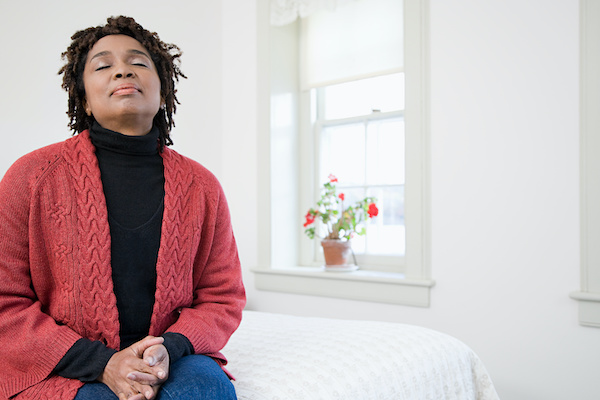How to Manage Your Anxiety after a Cancer Diagnosis
by Kristy Case, LCSW, OSW-C
Anxiety is a natural response to a stressful event. And cancer is one of the most stressful events in a person’s life. It’s no wonder many people find themselves feeling anxious after learning they have cancer.
What is anxiety?
Anxiety can look like difficulty sleeping, tense muscles, disrupted digestion, and thoughts that won’t “turn off.” For anyone who has experienced anxiety, you know that it feels uncomfortable, scary, and in some instances, emotionally paralyzing.
Although most everyone would agree that feeling anxious is an unpleasant emotional state, some degree of anxiety is expected, and even healthy to have, when coping with cancer. Anxiety is a part of our body’s built-in alarm system that alerts us to danger. It’s an automatic and involuntary instinct, triggered by fear, that we mammals have developed to keep us safe. When danger is looming, anxiety helps notify us to pay attention and find safety.
Humans have a nervous system with two main branches: sympathetic (which activates the fight, flight, or freeze response) and parasympathetic (which tells us to relax, rest, and digest). When something is awry, our sympathetic nervous system sends signals out to the body to pay attention so we can keep safe. This quick, involuntary cascade of signals helps us prepare to fight, flee, or freeze in response to danger. The body may respond by sending extra blood to the muscles (fight), increasing our breath rate (flight), or not moving at all (freeze). When the sympathetic nervous system activates, you may feel your temperature rise, your palms sweat, your stomach twist, all signals that tell your brain to look out for danger and quickly find safety.
Anxiety can look like difficulty sleeping, tense muscles, disrupted digestion, and thoughts that won’t “turn off.”
In contrast, the parasympathetic nervous system restores the body to a state of calm by sending signals out to the body that let it know the threat has passed. This slower cascade of signals helps us prepare to relax, rest, and digest as the danger is gone and we can let our guard down. The body responds in a number of ways, such as audibly sighing, resuming a normal heart rate, and eventually feeling peaceful.
Since we have this nervous system, it’s a good idea to learn how to listen and respond to it, especially in times of high anxiety when the sympathetic nervous system becomes activated.
A simple tool for calming anxiety
Completely stopping anxiety is a tall task when facing the repeated stressors that come along with cancer. However, managing anxiety is possible. Think of it this way: Managing anxiety is like turning down the volume and frequency of your anxious feelings when they feel too loud and intense. It doesn’t take those feelings away completely, but it does make them more tolerable.
One natural way we can tone down anxiety is by stimulating a nerve in the body called the vagus nerve. This nerve starts in our brain stem, runs down the spine, and then branches off into the organs. When we stimulate this nerve, it sends signals to our parasympathetic nervous system to relax, rest, and digest.
This nerve can be stimulated in a variety of ways, most of them pretty simple.
- Deep and slow breathing: The trick to taking deeper, slower breaths is to allow the belly to expand as you inhale and then let it gently contract on the exhale. When we belly breathe, we activate our diaphragm muscle, which in turn stimulates the vagus nerve.
- Humming, singing, or gargling: When we hum, sing, or gargle, we vibrate our vocal cords. This vibration stimulates the vagus nerve.
- Massage: Reflexology is a type of massage that focuses on various areas of the body, such as the feet. Gentle massage of these areas can stimulate the vagus nerve. (Note: Before trying reflexology, or any other type of massage, ask your oncologist if massage is safe for you during treatment.)
One natural way we can manage anxiety is by stimulating a nerve in the body called the vagus nerve.
Practicing self-care
For many people, the stress of cancer forces them to reevaluate their self-care routines. If you are looking for things you can do to help reduce your anxiety, you have a variety of tools at your disposal. In addition to stimulating the vagus nerve, you can try talk therapy, joining a support group, exercise, mindfulness activities, and prescribed anxiety-reducing medications.
Self-care looks different for everyone. It can include both external and internal self-care tools. External self-care may look like taking a walk or spending time with friends. Internal self-care may be taking part in spiritual practices, meditation, or loving affirmations. Other ways you can care for yourself after a cancer diagnosis include accepting help when it’s offered, turning down social invitations you’re not feeling up for, and asking your healthcare providers for information on cancer support resources or mental health services.
Managing anxiety while coping with cancer is an ongoing process. It requires awareness, practice, and patience to make the best use of the self-care tools available to you. The first step is to find what works for you, and then commit to doing it. Taking the time to care for yourself is an important part of healing after cancer.

Kristy Case is a licensed clinical social worker and certified oncology social worker with over 15 years of experience helping people and families affected by cancer and major illnesses. She works as the outpatient oncology social worker at her local cancer center and has a private therapy practice. Additionally, she teaches continuing education workshops for social workers at local universities. Kristy is also a trained yoga teacher and reiki practitioner. She incorporates an integrated healthcare approach in her work. She can be reached by email at Kristy.Case@gmail.com, or you can visit her website, JamesStreetCounseling.com, to learn more.
This article was published in Coping® with Cancer magazine, November/December 2022.


